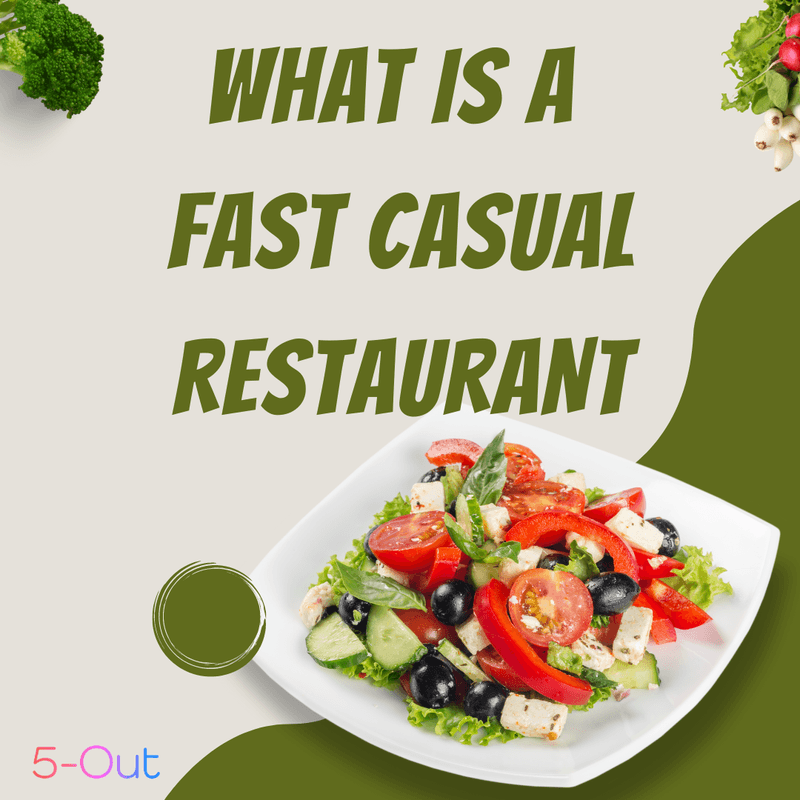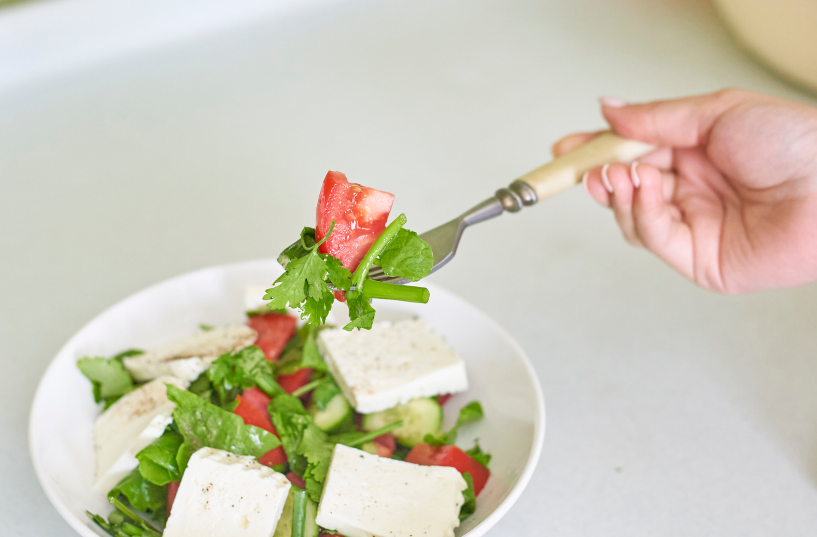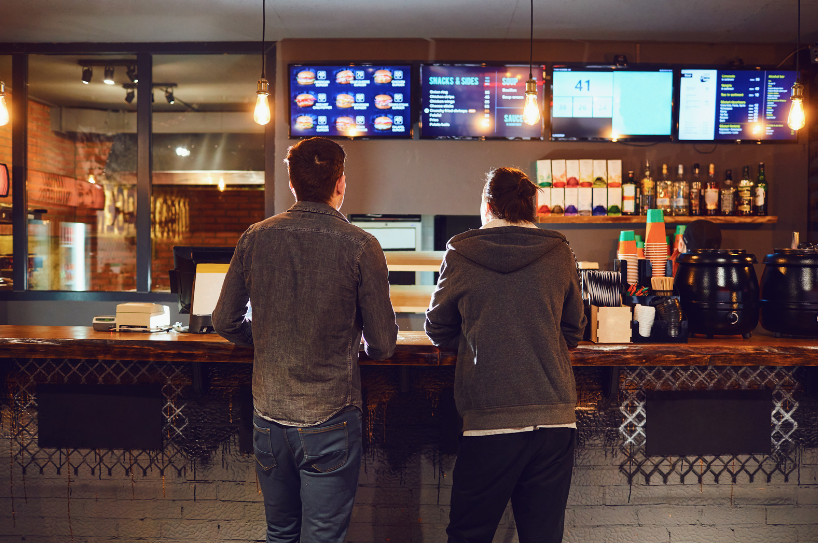What is a Fast Casual Restaurant
- Michael Jones

- Aug 15, 2024
- 10 min read
Updated: Aug 1
A fast casual restaurant is a type of dining establishment that blends elements of both fast food and casual dining.
Restaurant Industry

The fast casual restaurant concept is reshaping the dining landscape, offering a balance between fast food convenience and casual dining quality. As a restaurant owner, understanding this trend is essential for staying competitive in today's market. Popular examples of fast casual restaurants include Chipotle, Panera Bread, and Shake Shack—each known for providing fresh, customizable, and affordable meals in a comfortable setting. Fast casual dining has been rapidly growing, driven by consumer demand for exactly these kinds of experiences. This blog will explain what a fast casual restaurant is, why it's popular, and how it can impact your business. By understanding these trends, you can better position your restaurant for success in this evolving industry.

Fast Casual Restaurants are...
A fast casual restaurant is a type of dining establishment that blends elements of both fast food and casual dining. It offers higher-quality food than typical fast food establishments, but it maintains the convenience of quick service. Customers can expect fresh, often healthier options at a price point that is more affordable than full-service casual dining.
Key Characteristics of Fast Casual Restaurants
Quality of Food:
Fast casual restaurants are known for their commitment to using fresh, often locally sourced ingredients.
Menus typically include healthier options, such as salads, whole grains, and lean proteins.
There is a strong focus on offering made-to-order meals, ensuring freshness and customization to cater to individual preferences.
Pricing:
The pricing in fast casual restaurants is generally mid-range, sitting between fast food chains and casual dining.
Customers are willing to pay a bit more for the higher quality of ingredients and the overall dining experience.
Ambiance:
Fast casual restaurants prioritize creating a welcoming and comfortable environment.
Interiors are often modern and stylish, designed to encourage diners to enjoy their meals in a relaxed setting.
Unlike the utilitarian design of a fast food restaurant, a fast casual restaurant invests in creating a more inviting atmosphere.
Service Model:
Fast casual restaurants operate on a counter service model, where customers place their orders at the counter.
Speed is a key element, with an emphasis on delivering freshly prepared meals quickly.
While there is no traditional table service, many fast casual restaurants offer the option for customers to pick up their food from the counter or have it delivered to their table.

Comparing Fast Casual with Other Restaurant Models
Fast Food vs. Fast Casual
Food Quality:
Fast Food: Fast food restaurants generally rely on mass-produced, pre-prepared items that are designed for quick assembly and service. These foods are often highly processed, with a focus on taste and convenience over nutritional value.
Fast Casual: In contrast, fast casual restaurants emphasize fresh ingredients that are often healthier and less processed. The food is typically made-to-order, allowing for customization to meet dietary preferences or needs.
Service Model:
Fast Food: Both fast food and fast casual restaurants use a counter service model, where customers order at the counter and either pick up their food immediately or have it brought to their table.
Fast Casual: However, fast casual takes the service model a step further by offering more personalized options. For example, customers can often customize their meals, choosing specific ingredients or modifying dishes to suit their tastes.
Ambiance:
Fast Food: The ambiance in fast food restaurants is designed to prioritize speed and efficiency, with simple, utilitarian decor that encourages quick dining and turnover.
Fast Casual: On the other hand, fast casual restaurants focus on providing a more comfortable and inviting dining environment. The decor is often modern and stylish, with a layout that encourages diners to relax and enjoy their meal, even if they’re eating quickly.
Pricing:
Fast Food: Fast food is known for being budget-friendly, offering meals at low prices due to the use of cheaper, mass-produced ingredients.
Fast Casual: While still affordable, fast casual restaurants tend to be slightly more expensive than fast food. This price difference reflects the higher quality of ingredients and the overall dining experience that fast casual restaurants provide.
Fast Casual vs. Fine Casual
Food Quality:
Fast Casual: Fast casual restaurants prioritize fresh, high-quality ingredients, but the focus is on creating meals that are both delicious and convenient. The food is often healthier than fast food, but it remains accessible and straightforward.
Fine Casual: Fine casual restaurants take food quality to the next level, often offering gourmet, chef-driven dishes that emphasize creativity and culinary excellence, similar to what you'd find in fine dining restaurants. The ingredients are typically of the highest quality, and the presentation is more refined.
Service Model:
Fast Casual: The service in fast casual restaurants is primarily counter-based, with a focus on speed and efficiency. Customers order at the counter and either pick up their food or have it delivered to their table.
Fine Casual: Fine casual restaurants may offer a hybrid service model, combining elements of both counter service and table service. For instance, customers might order at the counter but receive more attentive service at their table, such as food brought to them by staff or additional table-side service.
Ambiance:
Fast Casual: The ambiance in fast casual restaurants is casual yet comfortable, with modern decor that appeals to a broad audience. The environment is designed to be inviting but not overly formal, making it suitable for a quick lunch or a relaxed dinner.
Fine Casual: Fine casual restaurants, however, emphasize a more upscale and polished dining experience. The focus is often on design and aesthetics, with thoughtful decor and a well-curated atmosphere that enhances the dining experience.
Pricing:
Fast Casual: A fast casual dining restaurant is priced to be accessible to a wide range of customers, offering good value for the quality of food and experience.
Fine Casual: Fine casual restaurants are generally more expensive, as they bridge the gap between casual dining and fine dining. The higher prices reflect the gourmet quality of the food, the enhanced service, and the refined ambiance.

Why Fast Casual Restaurants Are Thriving
Consumer Behavior
Why Today's Diners Prefer Fast Casual Over Traditional Dining Formats:
Modern diners are increasingly looking for a balance between quality and convenience. Fast casual restaurants meet this need by offering high-quality food without the time commitment required by traditional sit-down restaurants.
Many people today lead busy lives and are looking for dining options that fit into their schedules. Fast casual restaurants provide a quick service restaurant dining experience without sacrificing the quality of the meal.
The casual yet comfortable atmosphere of fast casual restaurants also appeals to those who want to enjoy a good meal in a relaxed setting without the formality of traditional dining.
Importance of Customization, Health Consciousness, and Convenience:
Customization: One of the major draws of fast casual dining is the ability to customize meals. Customers can choose ingredients and modify dishes according to their preferences, dietary needs, or allergies. This level of personalization is not typically offered in fast food or traditional dining.
Health Consciousness: Today’s diners are more health-conscious and prefer meals made with fresh, wholesome ingredients. Fast casual restaurants often highlight the use of organic, non-GMO, and locally sourced ingredients, catering to the growing demand for healthier eating options.
Convenience: Fast casual restaurants offer the convenience of quick service while still providing a high-quality dining experience. This combination appeals to a wide range of customers, from busy professionals to families looking for a quick yet satisfying meal.
Technology's Role
Impact of Online Ordering, Mobile Apps, and Delivery Services:
Online Ordering: Fast casual restaurants have embraced technology to enhance customer convenience. Many offer online ordering systems that allow customers to place their orders ahead of time and pick them up at their convenience. This reduces wait times and makes the dining experience even more efficient.
Mobile Apps: The development of mobile apps has further streamlined the ordering process. Customers can browse menus, customize their orders, and pay directly through the app, all from their smartphones. Some apps even offer rewards programs and personalized promotions, increasing customer loyalty.
Delivery Services: The rise of third-party delivery services like UberEats, DoorDash, and Grubhub has expanded the reach of fast casual restaurants. Customers can enjoy their favorite meals without leaving their homes, further boosting the appeal of fast casual dining.
Use of Social Media and Digital Marketing in Promoting Fast Casual Restaurants:
Social Media: Fast casual restaurants leverage social media platforms like Instagram, Facebook, and Twitter to connect with their customers. By sharing mouth-watering photos of their dishes, promoting special offers, and engaging with their audience, these restaurants can build a strong online presence and attract more customers.
Digital Marketing: In addition to social media, fast casual restaurants use targeted digital marketing strategies, such as email campaigns, online ads, and influencer partnerships, to reach their audience. These strategies help restaurants promote new menu items, special events, and brand messages, driving traffic and boosting sales.
Online Reviews and Ratings: Customer reviews and ratings on platforms like Yelp, Google, and TripAdvisor also play a significant role in the success of fast casual restaurants. Positive reviews can attract new customers, while responding to feedback helps build trust and improve service quality.

How to Transition or Start a Fast Casual Restaurant
1. Assessing Your Current Restaurant Model
Evaluate Your Existing Concept: Start by examining your current restaurant model. Consider what aspects are working well and where there might be room for improvement. Understanding your strengths and weaknesses will help you determine if transitioning to a fast casual concept is the right move.
Understand Your Target Audience: Analyze your customer base. Are they looking for faster service, healthier options, or a more casual dining experience? Knowing what your customers want can guide your transition process.
Consider Your Operational Capacity: Assess your kitchen setup, staffing, and supply chain. Can your current operations handle the faster pace and higher turnover typical of fast casual dining? If not, what changes will be necessary?
2. Key Considerations for Transitioning to a Fast Casual Concept:
Menu Simplification: One of the hallmarks of fast casual dining is a streamlined menu that focuses on a few key offerings. Simplifying your menu not only speeds up service but also allows you to focus on quality and consistency. Choose dishes that are easy to prepare quickly without sacrificing taste or presentation.
Efficiency in Service: Transitioning to a fast casual model requires rethinking how you serve customers. Counter service should be efficient, with an emphasis on speed and accuracy. Consider investing in technology like digital ordering kiosks or mobile apps to streamline the ordering process.
Design and Ambiance: The atmosphere in a fast casual restaurant should be inviting yet efficient. Consider updating your interior to reflect a modern, comfortable vibe. Seating should be arranged to accommodate both quick meals and longer stays, with a mix of tables, booths, and communal seating options.
Training and Staffing: Staff training is crucial during the transition. Your team needs to be able to work efficiently while maintaining a high level of customer service. This might include training on new equipment, service protocols, or customer interaction techniques.
3. Financial Planning, Menu Development, and Branding Strategies:
Financial Planning: Transitioning to a fast casual model will likely require some upfront investment, whether it’s in new equipment, renovations, or marketing. Create a detailed budget that accounts for these expenses. Consider seeking advice from a financial planner who specializes in the restaurant industry to ensure your plan is viable.
Menu Development: Develop a menu that aligns with fast casual dining trends. Focus on fresh, high-quality ingredients and offer customizable options. Your menu should be easy to execute quickly while still providing a satisfying and memorable dining experience. Additionally, pricing should reflect the value proposition of your fast casual concept, striking a balance between affordability and profitability.
Branding Strategies: Rebranding may be necessary to reflect your new fast casual identity. This includes everything from your restaurant’s name and logo to your marketing materials and online presence. Your branding should convey the essence of fast casual dining—quality, speed, and convenience. Consider launching a marketing campaign to introduce your new concept to existing customers and attract new ones.
Market Research: Before launching your fast casual restaurant, conduct thorough market research to understand the competition and identify gaps in the market that your restaurant can fill. This research can also help you fine-tune your concept to better meet customer expectations and stand out in a crowded marketplace.
Using Restaurant Management Software for Better Management
1. Point of Sale (POS) Systems:
A modern POS system is essential for fast casual restaurants, as it streamlines the ordering and payment processes. These systems allow for quick order entry, processing, and payment, reducing wait times and improving the overall customer experience.
POS systems can also integrate with other restaurant management tools, such as inventory management and customer relationship management (CRM) systems, providing a seamless flow of information that helps you manage your operations more efficiently.
2. Inventory Management:
Effective inventory management is crucial in a fast casual setting where fresh ingredients are a priority. Inventory management software helps track stock levels in real-time, alerting you when items are running low and even automating the ordering process to ensure you’re always well-stocked.
By reducing waste and ensuring that you have the right ingredients on hand, inventory management tools can help you maintain the quality and consistency that fast casual customers expect.
3. Labor Management:
Managing staff efficiently is vital to the success of a fast casual restaurant, where speed and service quality are key. Labor management software helps you create optimized schedules, track employee hours, and manage payroll, ensuring that you have the right number of staff on hand during peak times without overspending on labor costs.
These tools can also assist with compliance, ensuring that your scheduling practices adhere to labor laws and reducing the administrative burden on your management team.
4. Sales Forecasting with 5-Out:
For advanced sales forecasting, consider integrating 5-Out, an all-in-one platform that uses next-generation AI and machine learning to analyze both internal and external data. This tool predicts future demand down to the item level, helping you plan more accurately for the future.
5-Out seamlessly integrates with your existing restaurant management system, automating crucial tasks such as scheduling, budgeting, prep list creation, and order purchasing. By leveraging this technology, you can ensure that your restaurant is always prepared for customer demand, reducing waste, and maximizing efficiency.
Transitioning to or starting a fast casual restaurant can be a rewarding venture, offering a blend of quality, speed, and convenience that today’s diners crave. By carefully assessing your current restaurant model, refining your menu and service, and leveraging advanced restaurant management software, you can create a successful fast casual concept that stands out in a competitive market. With the right strategies and tools in place, your restaurant can thrive in this growing industry.
Ready to take your fast casual restaurant to the next level? Request a demo of 5-Out today and discover how advanced AI-driven sales forecasting can streamline your operations, optimize your resources, and help you meet customer demand with precision.



Comments